There are thousands of reference books about drawing faces, but only the good ol' Illustration Art blog will talk to you about drawing the backs of heads.
Most people sitting in an auditorium will ignore the rows and rows of dark, featureless, identical ovals in front of them. Nothing to see, right?
But recently I had the privilege of viewing the sketchbooks of illustrator William A. Smith and was impressed by the number of times he sat in large audiences and studied the backs of the heads in front of him. Looking at his insightful sketches, I realized that a subject I thought was uniform and uninteresting was really overflowing with variety and choices. People slouched in different ways. Their shoulders were uneven. They cocked their heads in various postures. And Smith's razor sharp eyes caught it all.
I have only a few isolated examples here, but Smith did some some superb detailed drawings containing multiple figures at what would otherwise have been a pretty dull lecture. They are in the collection of the Michener Museum.
Robert Fawcett is another illustrator who found challenges in the backs of people's heads. He never drew on automatic pilot.
If you study these heads with the same open eyes that Fawcett employed to view the originals, you'll recognize that no two are the same. Fawcett came up with some surprisingly wild and jagged ways to depict a subject the rest of us never even notice:













12 comments:
I used to draw the people in front of me when I rode the bus to school. Then I would draw the people sitting in front of me in class, one of whom would have great complex hairstyles that would take most of the class period to capture. The Pentel Rolling Writer has a great texture when slightly tilted that would capture the texture of hair very well. I learned more on those bus rides than in any art class I took.
I always love Illustration Art, no matter what you're posting about. Of all the "categories" that your posts fall into, this kind of thing is my absolute favorite. Nobody does these super-specific deep dives into esoteric examples of technical mastery like you do. Thanks!
I heard about Smith and Fawcett from this blog. They're both good.
i have to say David, it never occurred to me that the backs of heads might not be considered interesting.
Great article David. I like to spend time on airplane flights drawing and aisle seats give you a view of a series of elbows and nodding heads for several hours. They can be quite interesting and while I did not think much of them initially, I discovered, first of all drawing heads from behind and more so, slightly angled was really hard for me. All the usual landmarks were missing.
Also I noticed Fawcetts texturing of hair is so masterful. Another artist who does hair very well and diligently is Mort Drucker.
In animation, comics, and story-boarding, the artist needs to exercise more care with backs of heads in the composition due to the fact that the characters are simplified and abstracted, so the viewer may not recognize the character. In cases where an important character's head is in the frame, the head angle is often cheated so that viewers can see the side of the face and some expression. Over-the-shoulder shots may present some difficulty due to the character's shape being less recognizable. Brad Bird has published some notes about this, re story-boarding for the Simpsons.
Nice post David.
The wonderful thing about the Fawcett is the guy in the middle of the second row from us; the way he leans slightly sideways in his chair in concentration of what the lecturer is talking about animates the entire audience by contrast to the other listeners, gives poise and direction to the entire drawing in fact. And we notice this, I feel, because we are only shown the back of people's heads.
AJA-- That's a fun story. How did you do in those classes?
Josh Werth-- Thanks so much for your kind reaction. It does me a lot of good to hear that these little stories resonate with others.
MORAN-- If I've introduced anyone to two of the most neglected and underestimated masters of American illustration, then it was time well spent.
Laurence John-- It never occurred to me either until Smith and Fawcett pointed it out to me.
Untitled wrote: "All the usual landmarks were missing." Yes, that's the challenge isn't it? Faces have strong, distinctive features but in order to find landmarks in a thatch of hair or the backs of ears requires an artist with eyes like a hawk. On the other hand, the backs of heads leave more room for abstraction, of which most good artists will take advantage.
David J. Smith-- Thanks, that's an interesting spin on this issue. I imagine that in animation and storyboarding, the key characters have distinctive silhouettes to help with the recognition problem you describe. Of course, the number of characters in animation and storyboarding are necessarily limited because the action moves so quickly. There is no time to study the backs of large numbers of people and to draw distinctions before you are whisked away to the next scene.
David,
you read my comment above wrong... have another look.
backs of ears & hair; great shapes to draw.
I surprisingly did pretty well in those classes, especially since one of them was a tough physics class.
Tomer Hanuka draws some really nice backs of heads
Post a Comment